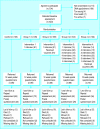The Newcastle exercise project: a randomised controlled trial of methods to promote physical activity in primary care
- PMID: 10496829
- PMCID: PMC314213
- DOI: 10.1136/bmj.319.7213.828
The Newcastle exercise project: a randomised controlled trial of methods to promote physical activity in primary care
Abstract
Objective: To evaluate the effectiveness of combinations of three methods to promote physical activity.
Design: Randomised controlled trial. Baseline assessment with post-intervention follow up at 12 weeks and 1 year.
Setting: One urban general practice, 1995-7.
Participants: 523 adults aged 40 to 64 years, randomised to four intervention groups and a control group.
Interventions: Brief (one interview) or intensive (six interviews over 12 weeks) motivational interviewing based on the stages of change model of behaviour change, with or without financial incentive (30 vouchers entitling free access to leisure facilities).
Main outcome measures: Physical activity score; sessions of moderate and vigorous activity in the preceding four weeks.
Results: Response rate was 81% at 12 weeks and 85% at one year. More participants in the intervention group reported increased physical activity scores at 12 weeks than controls (38% v 16%, difference 22%, 95% confidence interval for difference 13% to 32%), with a 55% increase observed in those offered six interviews plus vouchers. Vigorous activity increased in 29% of intervention participants and 11% of controls (difference 18%, 10% to 26%), but differences between the intervention groups were not significant. Short term increases in activity were not sustained, regardless of intensity of intervention.
Conclusions: The most effective intervention for promoting adoption of exercise was the most intensive. Even this did not promote long term adherence to exercise. Brief interventions promoting physical activity that are used by many schemes in the United Kingdom are of questionable effectiveness.
Comment in
-
The Newcastle exercise project. Conclusions are misleading.BMJ. 2000 May 27;320(7247):1470-1; author reply 1473-4. BMJ. 2000. PMID: 10877560 Free PMC article. No abstract available.
-
The Newcastle exercise project. Headline for This week in the BMJ is misleading.BMJ. 2000 May 27;320(7247):1471; author reply 1473-4. BMJ. 2000. PMID: 10877561 No abstract available.
-
The Newcastle exercise project. Jury is still out.BMJ. 2000 May 27;320(7247):1471; author reply 1473-4. BMJ. 2000. PMID: 10877562 No abstract available.
-
The Newcastle exercise project. Key messages are misleading and conclusions are not evidence based.BMJ. 2000 May 27;320(7247):1471-2; author reply 1473-4. BMJ. 2000. PMID: 10877563 No abstract available.
-
The Newcastle exercise project. Group support is crucial to success.BMJ. 2000 May 27;320(7247):1472; author reply 1473-4. BMJ. 2000. PMID: 10877564 No abstract available.
-
The Newcastle exercise project. Organisational aspects may influence adherence rates.BMJ. 2000 May 27;320(7247):1472; author reply 1473-4. BMJ. 2000. PMID: 10877565 Clinical Trial. No abstract available.
-
The Newcastle exercise project. Different exercise prescription schemes deserve evaluation in United Kingdom.BMJ. 2000 May 27;320(7247):1473. BMJ. 2000. PMID: 10877566 No abstract available.
-
The Newcastle exercise project. Excluded patients should be encouraged to take up exercise.BMJ. 2000 May 27;320(7247):1473. BMJ. 2000. PMID: 10877567 No abstract available.
-
The Newcastle exercise project. National quality assurance framework will guide best value and practice in GP exercise referral schemes.BMJ. 2000 May 27;320(7247):1474. BMJ. 2000. PMID: 10877568 No abstract available.
References
-
- Byrne A, Byrne DG. The effect of exercise on depression, anxiety and other mood states: a review. J Psychosom Res. 1993;37:565–574. - PubMed
-
- Sports Council; Health Education Council. Allied Dunbar national fitness survey: main findings. Northampton: Sports Council, Health Education Authority; 1992.
-
- Taylor A. Evaluating GP exercise referral schemes: findings from a randomised controlled study. Brighton: Chelsea School Research Centre, University of Brighton; 1996. (CSRC topic report 6.)

